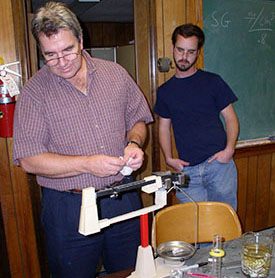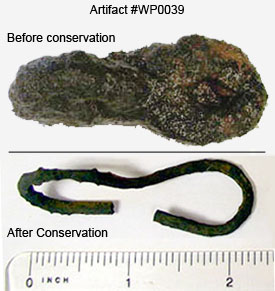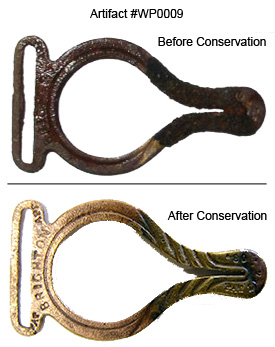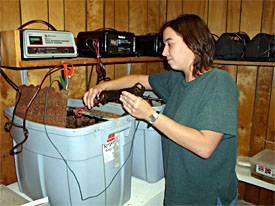ECU's 2006 Fall Field School
Project Journal
20 November 2006
By Michelle Damian

Amy has finished the preliminary lines drawings, allowing the rest of us to start creating conjectural deck plans, rigging drawings, and construction drawings based on research on similar vessels. We are almost entirely done with the site plan and will likely proceed to inking a final version of it soon. In the meantime we’ve continued to work on our individual research areas. Our artifacts are taking me places I’d never expected!

Dr. Rodgers and Adam test the specific gravity of a mystery material (it was magnesium).
Taking Conservation class in conjunction with this field school has been incredibly beneficial. Under Dr. Brad Rodgers’ instruction, Amy, Adam, another student named Jamie (not a field school participant) and I have been working the past few weeks on proper cleanup and conservation of the iron, brass, and copper artifacts. The “before and after” photographs of the objects give a clear picture of just how much of a difference conservation makes! In a nutshell, we’ve treated the objects with a galvanic wrap (reducing corrosion), performed electrolysis on the iron objects to remove concretions and arrest further corrosion, rinsed them, and treated them with preservatives to maintain their present appearance. We have tested other objects of indeterminate material to discover their specific gravity to help identify them more fully. It’s been amazing to see the detail revealed as treatment progresses.

This unidentifiable object was revealed to be a bedspring after removing concretions.
Some of the objects have been a bit disappointing. Each object has been catalogued by number for consistent identification. When we brought up #WP0039 from the site, it was encased with concretion. Based on the general shape we guessed that it might be some sort of rigging element. Electrolysis helped us safely break off the concretions… to reveal what appears to be a relatively modern steel bedspring. So much for our clue to the ship's rigging patterns!
One small object has become my "new favorite artifact" -' at least until I can devote more time to researching those mystery marbles! This 1.5 inch long flat brass piece is a suspender buckle. On Tuesday we began scrubbing off the layer of sediment, not expecting to see much underneath it. Imagine how our interest was piqued as decorative ribbing was revealed, followed by letters spelling "BRIGHTON." On the narrow end letters appear to spell "PAT DEC [or DEG] .08" possibly indicating a patent date. We had originally thought that it might actually be patent number 8 or 80, but a quick search showed that both of those patents were for woodcutting machinery, so there went that theory! "Brighton" may indicate a British maker, so I will be investigating British patents in the days to come.

Conservation shows detail of suspender buckle.
Not knowing anything about suspender buckles, I turned to the experts: museum professionals in the costume and clothing field. It's been fun to hear the reactions of people on the other end of the phone when I've introduced myself and what I'm looking for. "I'm a graduate student in maritime archaeology at East Carolina University. We were working on a shipwreck site, found something that looks like a suspender buckle, and are trying to identify a date for it. Can you help?" Generally there's a moment of silence followed by a slow, questioning "Okay ... ?" That initial surprise at such an esoteric query overcome, everyone I have asked has been incredibly helpful. I owe a debt of gratitude to the kind curators and professors at the Textile Museum, the Smithsonian Institution's National Museum of American History, and the Fashion Institute of Technology, all of whom have searched their records and collections for anything similar to our artifact. Though there are no matches to date, all have provided suggestions of other places to continue the investigation. If anyone reading this has any knowledge of suspender buckles, please let me know!
For our other artifacts, I've also been checking with places such as the Coca-Cola bottling factory in Washington and with the online Dr. Pepper Museum to determine a date for the soda bottles we have found on the site. Books on ship fastening manufacture will help identify our various iron spikes and nails, helping us determine a date for the construction. Today I also received a notice that my interlibrary loan has arrived -' I requested a book entitled Colonial Period & Early 19th Century Children's Toy Marbles. Perhaps a bit early for our site, but I know as much about marbles as I do about suspender buckles, so it's a start.

Michelle puts an artifact into electrolysis.
Even though these artifacts may not date to the time of wreck itself, they will still reveal some information about the site in general. The Coke bottles were likely placed deliberately on site as they were clumped in the same area. If we find a lot of what is apparently trash all dating to approximately the same time, we may extrapolate that at one time the site was a known garbage dump. The fact that these early 20th-century objects are all still there and remained covered with sand, undisturbed, for so long tells us that there was little traffic around the site for decades. Each artifact is another piece of the entire puzzle.
And we haven't even begun conserving the wooden, leather, and other organic artifacts yet!
For more information you can visit the ECU website at:
http://www.ecu.edu/maritime/index.htm
Return to Project Journal home page.

